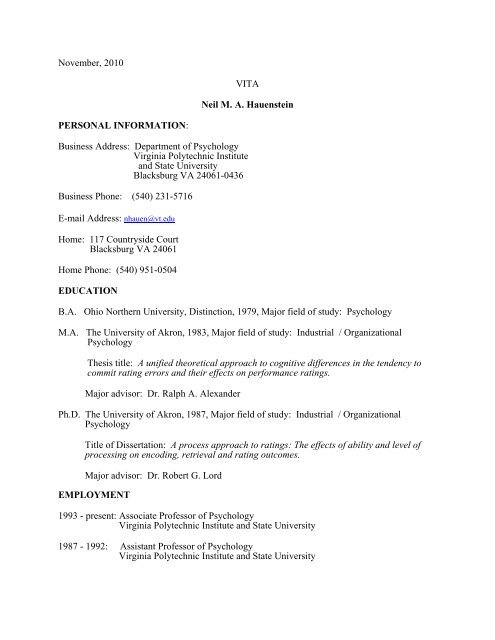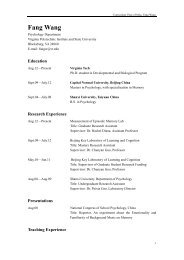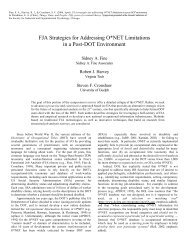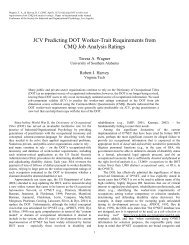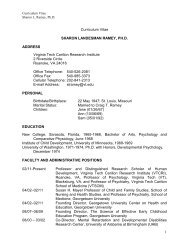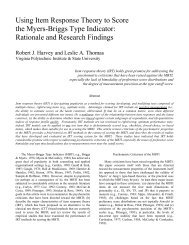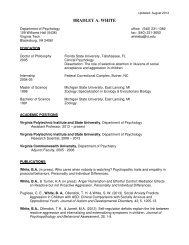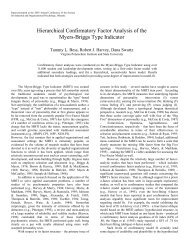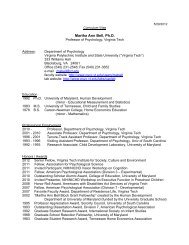Curriculum Vitae - Psychology Department
Curriculum Vitae - Psychology Department
Curriculum Vitae - Psychology Department
You also want an ePaper? Increase the reach of your titles
YUMPU automatically turns print PDFs into web optimized ePapers that Google loves.
November, 2010VITANeil M. A. HauensteinPERSONAL INFORMATION:Business Address: <strong>Department</strong> of <strong>Psychology</strong>Virginia Polytechnic Instituteand State UniversityBlacksburg VA 24061-0436Business Phone: (540) 231-5716E-mail Address: nhauen@vt.eduHome: 117 Countryside CourtBlacksburg VA 24061Home Phone: (540) 951-0504EDUCATIONB.A. Ohio Northern University, Distinction, 1979, Major field of study: <strong>Psychology</strong>M.A. The University of Akron, 1983, Major field of study: Industrial / Organizational<strong>Psychology</strong>Thesis title: A unified theoretical approach to cognitive differences in the tendency tocommit rating errors and their effects on performance ratings.Major advisor: Dr. Ralph A. AlexanderPh.D. The University of Akron, 1987, Major field of study: Industrial / Organizational<strong>Psychology</strong>Title of Dissertation: A process approach to ratings: The effects of ability and level ofprocessing on encoding, retrieval and rating outcomes.Major advisor: Dr. Robert G. LordEMPLOYMENT1993 - present: Associate Professor of <strong>Psychology</strong>Virginia Polytechnic Institute and State University1987 - 1992: Assistant Professor of <strong>Psychology</strong>Virginia Polytechnic Institute and State University
EMPLOYMENT CONTINUED1985 - 1987: Instructor of <strong>Psychology</strong>Radford University1984 - 1985: Instructor of ManagementThe University of Akron1981 - 1984: Graduate Teaching Assistant of StatisticsThe University of AkronHONORS, AWARDS, AND INVITED TALKS2010: Summer Research Fellow at the Defense Equal Opportunity Management Institute,Patrick Air Force Base, Cocoa Beach, Florida. Sponsored by the Office of Naval Researchand administered by the American Society for Engineering Education.2005: Summer Research Fellow at the Defense Equal Opportunity Management Institute,Patrick Air Force Base, Cocoa Beach, Florida. Sponsored by the Office of Naval Researchand administered by the American Society for Engineering Education.2004: Summer Research Fellow at the Defense Equal Opportunity Management Institute,Patrick Air Force Base, Cocoa Beach, Florida. Sponsored by the Office of Naval Researchand administered by the American Society for Engineering Education.2004: Advisor for Dr. Kevin Bradley, whose dissertation won the 2004 student papercompetition from the International Personnel Management Association for HumanResources Assessment Council.2003: Invited workshop for the Personnel Testing Council of Metropolitan Washington.2003: Invited Speaker, 23 rd Annual conference of the Industrial Organizational-OrganizationalBehavior Conference sponsored by Division 14 of the American PsychologicalAssociation2002: Colloquium Presentation, <strong>Department</strong> of <strong>Psychology</strong>, Auburn University.2002: Colloquium Presentation, <strong>Department</strong> of <strong>Psychology</strong>, University of North Carolina,Charlotte.2001: Invited Speaker, 31 st Annual Conference on Labor Relations and EmploymentLaw, Charlottesville, Virginia.2000: Visiting Associate Professor of Management, <strong>Department</strong> of Management, BondUniversity, Gold Coast Australia.1998: Keynote Speaker, 13 th Annual Lehigh Valley Undergraduate <strong>Psychology</strong>Conference, Moravian College, Bethlehem Pennsylvania.3
HONORS, AWARDS, AND INVITED TALKS CONTINUED1996: Invited speaker, Harrison and Crosfield Corporate Human Resources Meeting. St. Louis,Missouri.1995: Summer Faculty Fellowship, Center for Excellence in Undergraduate Teaching.1986: Outstanding paper presentation, the Eastern Academy of Management.1984: Best graduate student presentation, American <strong>Psychology</strong> Association, Division FourteenWherry Award.PROFESSIONAL ORGANIZATIONS AND ACTIVITIESMember, Society of Industrial / Organizational <strong>Psychology</strong>Member, American Psychological SocietyEditorial Board, 2010, Journal of Business and <strong>Psychology</strong>Member, Awards Committee, 2009-2010, Society for Industrial /Organizational <strong>Psychology</strong>Chair, Distinguished Teaching Award Committee, 2003-2004, Society for Industrial /Organizational <strong>Psychology</strong>Member, Education and Training Committee, 2001-2004, Society for Industrial / Organizational<strong>Psychology</strong>Co-Editor, Education and Training Column, 2001-2004, appearing in The IndustrialPsychologistMember, Program Committee, 1992-2007, Society for Industrial / Organizational <strong>Psychology</strong>Annual MeetingMember, Division 14 Program Committee, 1989 - 1991, American PsychologicalAssociation Annual MeetingsMember, Program Committee, 1990 and 1991 Academy of Management Annual MeetingsAd hoc reviewer for Journal of Applied <strong>Psychology</strong>, Personnel <strong>Psychology</strong>, OrganizationalBehavior and Human Decision Processes, Organizational Research Methods, Journal ofOrganizational Behavior, Journal of Occupational and Organizational <strong>Psychology</strong>, Journal ofManagement, Journal of Social <strong>Psychology</strong>, and Sociological Methods and Research4
PUBLICATIONSHauenstein, N. M. A., Tison, E. B., & Holmes, J. T. (in press). Detecting Adverse Impact:The Four-Fifths Rule Versus Significance Testing. Public Personnel Management.Hauenstein, N. M. A., Brown, R. D., Sinclair, A. L. (2010). BARS and those mysterious,missing middle anchors. Journal of Business and <strong>Psychology</strong>, 25, 663-672.Hauenstein, N. M. A., & Findlay, R. A., McDonald, D. P. (2010). Situational JudgmentTests and Training Evaluation. Military <strong>Psychology</strong>, 22, 262-281.O’Shea, P. G., Foti, R. J., Hauenstein, N. M. A., & Bycio, P. (2009). Xavier UniversityTransformational and transactional leadership: The view from a pattern-oriented perspective.Leadership, 5, 237-259.Hauenstein, N. M. A. (2008). Detecting rating bias using differential prediction. PersonnelTesting Council Quarterly. 4, 6-10.Foti, R. J., & Hauenstein, N. M. A. (2007). Linking leadership emergence to leadershipeffectiveness in a military context. Journal of Applied <strong>Psychology</strong>, 92, 347-355.Bradley, K. M., & Hauenstein, N. M. A. (2006). The moderating effects of sample type asevidence of the effects of faking on personality scale correlations and factor structure.<strong>Psychology</strong> Science, 48, 313-335.Brown, R., & Hauenstein, N. M. A. (2005). Interrater agreement reconsidered: The role ofmaximum possible variance. Organizational Research Methods, 8, 1-20.Hauenstein, N. M. A., McGonigle, T., & Flinder, S. (2001). Meta-Analysis of therelationship between procedural and distributive Justice. Employee Responsibilities and RightsJournal, 13, 39-56.Hauenstein, N. M. A. (1998). Training raters to increase the accuracy and usefulness ofappraisals. In J. Smither (Ed.), Performance Appraisal: State-Of-The-Art Methods ForPerformance Management, (pp. 404-444). San Francisco: Josey Bass.Ni, Y., & Hauenstein, N. M. A. (1998). Effects of invasiveness and face validity ofpersonality test items on applicant reactions. Journal of Business <strong>Psychology</strong>, 12, 391-406.Smith, J., Hauenstein, N. M. A., & Buchanan, L. (1996). Goal setting and exerciseperformance. Human Performance, 9, 141-154.Foti, R. J., & Hauenstein, N. M. A. (1993). Processing demands and the effects of priorimpressions on subsequent judgments: Clarifying the assimilation/contrast debate.Organizational Behavior and Human Decision Processes, 54, 167-189.Stamoulis, D. T., & Hauenstein, N. M. A. (1993). Rater training and rating accuracy:training for dimensional accuracy versus training for ratee differentiation. Journal of Applied<strong>Psychology</strong>, 78, 994-1003.5
PUBLICATIONS CONTINUEDHauenstein, N. M. A. (1992). An information-processing approach to leniency inperformance judgments. Journal of Applied <strong>Psychology</strong>, 77, 485-493.Hauenstein, N. M. A., & Alexander, R. A. (1991). Rating ability in performance judgments:The joint influence of implicit theories and intelligence. Organizational Behavior and HumanDecision Processes, 50, 300-323.Hauenstein, N. M. A., & Lord, R. G. (1989). The effects of final-offer arbitration on theperformance of major league baseball players: A test of equity theory. Human Performance, 2,147-165.Hauenstein, N. M. A., & Foti, R. J. (1989). From laboratory to practice: Neglected issues inimplementing frame-of-reference rater training. Personnel <strong>Psychology</strong>, 42, 359-378.Hauenstein, N. M. A., & Lord, R. G. (1988). A Bayesian approach to leadershipperceptions: Numbers are no substitute for experience. In R. L. Cardy, S. M. Puffer, and J. M.Newman (Eds.), Advances in Information Processing in Organizations. (pp. 169-182).Greenwich, CT: JAI Press.PUBLICATIONS (Technical Reports, Conference Proceedings, and Editorials)Hauenstein, N. M. A. (2006). Estimation of Training Cost Savings and Salary Savings as aFunction of Decreasing Patrol Officer Turnover Rates.Hauenstein, N. M. A., Kutcher, E., & Findlay, R. (2005). Compensation Study of VirginiaLaw Enforcement Agencies.Hauenstein, N. M. A., Kutcher, E., & Findlay, R. (2005). Compensation Study of Mid-Atlantic Law Enforcement Agencies Comparable to Roanoke City.Hauenstein, N. M. A. (2001). Deconstructing graduate training. The Industrial Psychologist39, 39-42.Hauenstein, N. M. A., & McBride, N. L. (2000). Final Report on Exit Surveys of RetailEmployees of Advance Auto.McBride, N. L., & Hauenstein, N. M. A. (2000). Final Report on Exit Surveys ofDistribution Employees at Advance Auto.McBride, N. L., O'Shea, P. G., & Hauenstein, N. M. A. (2000). Automobile Retail IndustryReport on Turnover and Compensation Practices.O'Shea, P. G., & Hauenstein, N. M. A. (2000). Final Report on Exit Surveys ofAdministrative Employees at Advance Auto.Hauenstein, N. M. A., & Schmidt, J. (1999). Insurance industry survey on compensationpractices.6
PUBLICATIONS (Technical Reports, Conference Proceedings, and EditorialsCONTINUEDHauenstein, N. M. A., & Schmidt, J. (1999). Insurance industry survey on informationtechnologies.Hauenstein, N. M. A., & Schmidt, J. (1999). Insurance industry survey on training practice.Foti, R. J., Hauenstein, N. M. A., & Sgro, J. A. (1997). Linking leadership emergence toeadership effectiveness and team performance in a military population. (DASWo1-95-K-008).Foti, R. J., & Hauenstein, N. M. A. (1987). Differences in performance schemata as afunction of organizational level. (TR-ONR-10).Hauenstein, N. M. A., Whitcomb, A., & Foti, R. J. (1987). Effects of future interactions andtime delays on evaluator leniency. (TR-ONR-15).Hauenstein, N. M. A., & Foti, R. J. (1986). The effects of increasing processing demands onrating outcomes. In H. G. Gueutal & M. J. Kavanagh (Eds.), Proceedings of the EasternAcademy of Management, (pp. 201-205). Albany, NY: Suny-Albany.Foti, R. J., & Hauenstein, N. M. A. (1986). Controlled versus automatic processing in aperformance appraisal task. (TR-ONR-6).PRESENTATIONS AND PAPERSKutcher, E. J., Bragger, J. D., Masco, J. L., & Hauenstein, N. M. A. (2010, April). Howinterviewees consider content and context cues to person-organization fit. Interactive Poster atthe 25 th annual meeting of the Society of Industrial / Organizational <strong>Psychology</strong>, Atlanta,Georgia.The Future of SJTs: Where Do We Go From Here? (2009, April). N. Hauenstein (Panelist).Roundtable Discussion / Conversation Hour at the 24 th annual meeting of the Society ofIndustrial / Organizational <strong>Psychology</strong>, New Orleans, Louisiana.Osowski, J., & Hauenstein, N. M. A. (2009, April). Person and Situation Interactions andSelf-Regulation of Organizational Citizenship Behaviors. Paper presented at the 24 th annualmeeting of the Society of Industrial / Organizational <strong>Psychology</strong>, New Orleans, Louisiana.Esson, P., & Hauenstein, N. M. A. (2008, April). Type I and Type II Errors in AdverseImpact Detection. Paper presented at the 23 rd annual meeting of the Society of Industrial /Organizational <strong>Psychology</strong>, San Francisco, California.Findlay, R., & Hauenstein, N. M. A. (2008, April). Hybrid Scoring for Situational JudgmentTests Designed to Evaluate Training. Paper presented at the 23 rd annual meeting of the Societyof Industrial / Organizational <strong>Psychology</strong>, San Francisco, California.7
PRESENTATIONS AND PAPERS CONTINUEDHauenstein, N. M. A., & Tison, E. (2008, April). Rating Bias and Differential Prediction. .Paper presented at the 23 rd annual meeting of the Society of Industrial / Organizational<strong>Psychology</strong>, San Francisco, California.Hoffner, R., & Hauenstein, N. M. A. (2008, April). Personality Architecture: Applying aSocial-Cognitive Model to the Work Context. . Paper presented at the 23 rd annual meeting of theSociety of Industrial / Organizational <strong>Psychology</strong>, San Francisco, California.Kalanick, J. & Hauenstein, N. M. A. (2008, April). Helping in the Workplace: A SocialCognitive Perspective. Paper presented at the 23 rd annual meeting of the Society of Industrial /Organizational <strong>Psychology</strong>, San Francisco, California.SJT’s Aren’t Just for Selection: Use in Development and Training, (2008, April). N.Hauenstein (Panelist). Panel discussion presented at the 23 rd annual meeting of the Society ofIndustrial / Organizational <strong>Psychology</strong>, San Francisco, California.Hauenstein, N. M. A., Findlay, R., Kalanick, J. L., and Esson, P. L. (2007, April).Situational Judgment Tests and Training Evaluation. Paper presented at the 22 nd annual meetingof the Society of Industrial / Organizational <strong>Psychology</strong>, New York, New York.Hauenstein, N. M. A., Tison, E. B., Holmes, J. T., & Fife C. (2007, April). PracticalConsequences of Using the Four-Fifths Rule Versus Significance Tests. Paper presented at the22 nd annual meeting of the Society of Industrial / Organizational <strong>Psychology</strong>, New York, NewYork.Hoffner, R., Hauenstein, N. M. A. (2007, April). The Architecture of Personality in theContext of Work. Paper presented at the 22 nd annual meeting of the Society of Industrial /Organizational <strong>Psychology</strong>, New York, New York.Findlay, R., & Hauenstein, N. M. A. (2006, October). Scoring Key Development forSituational Judgment Tests Used in Training Evaluation. Paper presented at the annualconference of the Military Testing Association, Kingston, Ontario, Canada.Hauenstein, N. M. A., Esson, P., Findlay, R., & Kalanick, J. (2006, October). Evaluation ofDiversity Management Training Using Situational Judgment Testing. Paper presented at theannual conference of the Military Testing Association, Kingston, Ontario, Canada.Esson, P. L., Hauenstein, N. M. A. (2006, May). Adverse Impact: Four-Fifths Rule VersusStatistical Significance Testing in Courtrooms. Paper presented at the 21 st annual meeting of theSociety of Industrial / Organizational <strong>Psychology</strong>, Dallas, Texas.Hauenstein, N. M. A., Esson, P., Findlay, R., & Kalanick, J. (2006, May). Using SJTs toEvaluate Equal Opportunity and Diversity Training Programs. Paper presented at the 21 st annualmeeting of the Society of Industrial / Organizational <strong>Psychology</strong>, Dallas, Texas.8
PRESENTATIONS AND PAPERS CONTINUEDBradley, K. M., & Hauenstein, N. M. A. (2005, April). Applying Incumbent DerivedPrediction Equations to Job Applicant Samples. Paper presented at the 20 th annual meeting of theSociety of Industrial / Organizational <strong>Psychology</strong>, Los Angeles, California.Foti, R. J., Hauenstein, N. M. A. (2005, April). Linking Leadership Emergence toLeadership Effectiveness in a Military Context. Paper presented at the 20 th annual meeting of theSociety of Industrial / Organizational <strong>Psychology</strong>, Los Angeles, California.Frame-of-Reference Training: Insights and Best Practices, (2005, April). N. Hauenstein(Discussant). Practitioner Forum presented at the 20 th annual meeting of the Society of Industrial/ Organizational <strong>Psychology</strong>, Los Angeles, California.Hauenstein, N. M. A. (2005, July). How to Estimate and Interpret Interrater Agreement.‘How To’ session presented at the 6 th Australian Industrial & Organizational <strong>Psychology</strong>Conference, Gold Coast, Australia.Hauenstein, N. M. A., & Sinclair, A. L. (2005, July). A Protocol to Facilitate Interpretationof Results when Using Cronbach’s Components Accuracy Components. Paper presented at the 6 thAustralian Industrial & Organizational <strong>Psychology</strong> Conference, Gold Coast, Australia.Meet the TIP Editor and Editorial Board, (2005, April). N. Hauenstein (Discussant).Roundtable discussion presented at the 20 th annual meeting of the Society of Industrial /Organizational <strong>Psychology</strong>, Los Angeles, California.Bradley, K. M., & Hauenstein, N. M. A. (2004, April). Are personality scale correlationsinflated in job applicant samples? Paper presented at the 19 th annual meeting of the Society ofIndustrial / Organizational <strong>Psychology</strong>, Chicago, Illinois.Bradley, K. M., & Hauenstein, N. M. A. (2004, April). Do incumbent samples overestimatevalidities in applicant settings? Paper presented at the 19 th annual meeting of the Society ofIndustrial / Organizational <strong>Psychology</strong>, Chicago, Illinois.Hafsteinsson, L. G., & Hauenstein, N. M. A. (2004, April). Assessing interrater agreementwhen the number of raters is small. Paper presented at the 19 th annual meeting of the Society ofIndustrial / Organizational <strong>Psychology</strong>, Chicago, Illinois.Hauenstein, N. M. A., & Kutcher, E. J. (2004, April). Cronbach’s accuracy components andconcerns about the performance appraisal literature. Paper presented at the 19 th annual meetingof the Society of Industrial / Organizational <strong>Psychology</strong>, Chicago, Illinois.Sinclair, A. L., & Hauenstein, N. M. A. (2004, April). Disentangling contributions ofprocess elements to the fair process effect. Paper presented at the 19 th annual meeting of theSociety of Industrial / Organizational <strong>Psychology</strong>, Chicago, Illinois.9
PRESENTATIONS AND PAPERS CONTINUEDHauenstein, N. M. A., Sinclair, A. L., Robson, V., Quintella, Y., & Donovan, J. J. (2003,April). Performance Dimensionality and the Occurrence of Ratee Race Effects. Paper presentedat the 18 th annual meeting of the Society of Industrial / Organizational <strong>Psychology</strong>, Orlando,Florida.Hauenstein, N. M. A., Sinclair, A. L., Quintella, Y., Robson, V., & Donovan, J. J. (2003,April). Ratee Sex Effects in Job Performance: Is the Tide Turning? Paper presented at the 18 thannual meeting of the Society of Industrial / Organizational <strong>Psychology</strong>, Orlando, Florida.Interrater Agreement: Problems and Solutions. (2003, April) N. Hauenstein (Moderator),Panel Discussion presented at the 18 th annual meeting of the Society of Industrial /Organizational <strong>Psychology</strong>, Orlando, Florida.Bradley, K. M., & Hauenstein, N. M. A. (2002, April). Personality test validation research:Present-employee and job applicant samples. Paper presented at the 17 th annual meeting of theSociety of Industrial / Organizational <strong>Psychology</strong>, Toronto, Canada.Bradley, K. M., O'Shea, P. G., & Hauenstein, N. M. A. (2002, April). Factors related topersonality test response processes and response endorsements. Paper presented at the 17 thannual meeting of the Society of Industrial / Organizational <strong>Psychology</strong>, Toronto, Canada.Hauenstein, N. M. A., Brown, R. D., & Sinclair, A. L. (2002, April). BARS and thosemysterious, missing middle anchors. Paper presented at the 17 th annual meeting of the Society ofIndustrial / Organizational <strong>Psychology</strong>, Toronto, Canada.Hauenstein, N. M. A., Sinclair, A. L., Robson, V., Quintella, Y., & Donovan, J. J. (2002,April). Ratee race effects in performance: Task performance versus contextual performance.Paper presented at the 17 th annual meeting of the Society of Industrial / Organizational<strong>Psychology</strong>, Toronto, Canada.Lemmond, G. & Hauenstein, N. M. A. (2002, April). Nonvolitional faking: Testing theinfluence of unconscious process. Paper presented at the 17 th annual meeting of the Society ofIndustrial / Organizational <strong>Psychology</strong>, Toronto, Canada.O'Shea, P. O., Foti, R. J., Hauenstein, N. M. A., & Bycio, P. J. (2002, April). Exploringtransformational and transactional leadership from a pattern-oriented perspective. Paperpresented at the 17 th annual meeting of the Society of Industrial / Organizational <strong>Psychology</strong>,Toronto, Canada.Sinclair, A. L., & Hauenstein, N. M. A. (2002, April). A closer look at Cronbach's accuracycomponents as dependent variables. Paper presented at the 17 th annual meeting of the Society ofIndustrial / Organizational <strong>Psychology</strong>, Toronto, Canada.10
PRESENTATIONS AND PAPERS CONTINUEDSwartz, D. E., McBride, N. L., & Hauenstein, N. M. A. (2002, April). The benefits ofperforming exit interviews: A review and demonstration. Paper presented at the 17 th annualmeeting of the Society of Industrial / Organizational <strong>Psychology</strong>, Toronto, Canada.Hauenstein, N. M. A., Bess, T., Byrd, T., & Swartz, D. (2001, April). Combining predictorand criterion strategies to eliminate adverse impact. Paper presented at the 16 th annual meetingof the Society of Industrial / Organizational <strong>Psychology</strong>, San Diego, California.Sinclair, A., & Hauenstein, N. M. A. (2001, April). Differentiating rater accuracy trainingprograms. Paper presented at the 16 th annual meeting of the Society of Industrial /Organizational <strong>Psychology</strong>, San Diego, California.Hauenstein, N. M. A., Bradley, K. M., & O'Shea, P. G. (2000, April). Clarifying theprocess: Verbal reports of honest and faked personality test responses. Paper presented at the15 th annual meeting of the Society of Industrial / Organizational <strong>Psychology</strong>, New Orleans,Louisiana.McGonigle, T. P., Hauenstein, N. M. A. (2000, April). An investigation of the dimensionalityof organizational justice. Paper presented at the 15 th annual meeting of the Society of Industrial /Organizational <strong>Psychology</strong>, New Orleans, Louisiana.Hauenstein, N. M. A., Schmidt, J., & Facteau, J. (May, 1999). Rater variability training: Analternative to rater error training and frame-of-reference training. Paper presented at the 14 thannual meeting of the Society of Industrial / Organizational <strong>Psychology</strong>, Atlanta, Georgia.McGonigle, T., & Hauenstein, N. M. A. (May, 1999). Rater ability, motivation andcognitive ability effects on self-appraisal accuracy. Paper presented at the 14 th annual meeting ofthe Society of Industrial / Organizational <strong>Psychology</strong>, Atlanta, Georgia.Cooper, R. P., & Hauenstein, N. M. A. (1998, April). Looking as a measure of perceptualpreference in infants. In R. Cooper (Chair), Looking Where and Looking When: What VisualMeasures Can (and Cannot) Tell us About Infant Perception and Cognition. Symposiumpresented at the International Conference for Infant Studies, Atlanta, Georgia.Hauenstein, N. M. A. (April, 1998). Faking personality tests: Does it really matter? In M.McDaniel (Chair), Applicant Faking with Non-Cognitive Tests: Problems and Solutions. Paperpresented at the 13 th annual meeting of the Society of Industrial / Organizational <strong>Psychology</strong>,Dallas, Texas.Smith J. A., Hauenstein, N. M. A., Foti, R. J., & Hansen, T. (April, 1998). An examinationof test-taking attitudes and response distortion on a personality test. In A. Snell (Chair),Disentangling the Effects of Faking from Social Desirability: An Examination of MultipleMeasurement Strategies. Paper presented at the 13 th annual meeting of the Society of Industrial /Organizational <strong>Psychology</strong>, Dallas, Texas11
PRESENTATIONS AND PAPERS CONTINUEDHauenstein, N. M. A., McGonigle, T., & Flinder, S. (April, 1997). Meta-Analysis of theRelationship between Procedural and Distributive Justice. Paper presented at the 12 th annualmeeting of the Society of Industrial / Organizational <strong>Psychology</strong>, St. Louis, Missouri.Morgan, S. C., & Hauenstein, N. M. A. (May, 1997). Facilitating Idea Generation in aTeam Context. Paper presented at the annual meeting of the American Psychological Society,Washington D. C.Foti, R. J., & Hauenstein, N. M. A. (1996, April). Linking leadership emergence toleadership effectiveness in a military sample. In R. Foti (Chair), Linking Leadership Emergenceto Assessment Centers, Leader Effectiveness, and Development. Symposium presented and the11 th annual meeting of the Society of Industrial / Organizational <strong>Psychology</strong>, San Diego,California.Flinder, S., & Hauenstein, N. M. A. (1995, May). Distributive and Procedural Justice:Effects of Inputs, Outcomes, and Procedures. Paper presented at the 10 th annual meeting of theSociety of Industrial / Organizational <strong>Psychology</strong>, Orlando, Florida.Morgan, S. C., & Hauenstein, N. M. A. (1995, May). Effects of Context on the leniency andaccuracy of self-appraisals of performance. Paper presented at the 10 th annual meeting of theSociety of Industrial / Organizational <strong>Psychology</strong>, Orlando, Florida.Smith, J., Buchanan, L., Hauenstein, N. M. A., & Herrera, E. (1995, May). Goal settingand human performance. Paper presented at the 10 th annual meeting of the Society of Industrial/ Organizational <strong>Psychology</strong>, Orlando, Florida.Russell, A. & Hauenstein, N. M. A. (1994, April). Procedural justice and performanceappraisal: A test of Greenberg’s model. Paper presented at the 9 th annual meeting of the Societyof Industrial / Organizational <strong>Psychology</strong>, Memphis Tennessee.Stamoulis D. T., & Hauenstein, N. M. A. (1993, April). Rater training and rating accuracy:Training for dimensional accuracy versus training for ratee differentiation. In D. Day & LSulsky (Co-chairs), Rater Training and Performance Appraisal. Symposium presented at the 8 thannual meeting for the Society of Industrial / Organizational <strong>Psychology</strong>, San FranciscoCalifornia.Flinder, S. W., Hauenstein, N. M. A. (1993, August). Locus of control as a moderator of theinfluence and procedural justice relationship. Paper presented at the 100 th annual meeting of theAmerican Psychological Association, Toronto Canada.Hauenstein, N. M. A. (1992, May). Measuring halo in single rater-single employeesituations. Paper presented at the 7 th annual meeting of the Society of Industrial / Organizational<strong>Psychology</strong>, Montreal, Canada.Hauenstein, N. M. A. & Bush, J. (1992, May). Processing performance feedback:Competence versus self-enhancement. In R. Foti (chair), Feedback Readiness, FeedbackReactions, and Memory for Feedback Messages. Symposium presented at the 7 th annual meetingfor the Society of Industrial / Organizational <strong>Psychology</strong>, Montreal, Canada.12
PRESENTATIONS AND PAPERS CONTINUEDHauenstein, N. M. A. (1991, August). Self-motivation theories and memory forperformance feedback. In R. Foti (chair), Feedback Reactions, Memory for Feedback, andSubsequent Task Performance. Symposium presented at the 99 th annual meeting of theAmerican Psychological Association, San Francisco, California.Hauenstein, N. M. A., Brill, R. T., & Stamoulis, D. T. (1991, August). The moderatingeffect of "halo error" on test validity: Real or artifact. Paper presented at the 99 th annualmeeting of the American Psychological Association, San Francisco, California.Donlin, J. M., & Hauenstein, N. M. A. (1990, August). Memory for performance feedback:A test of three self-motivation theories. In H. H. Myer (chair), Performance Appraisal andFeedback. Symposium presented at the 98 th annual meeting of the American PsychologicalAssociation, Boston, Massachusetts.Hauenstein, N. M. A. (1990, August). New directions in goal setting. In N. Hauenstein(chair), Motivation and Goal Setting. Symposium presented at the 98 th annual meeting of theAmerican Psychological Association.Hauenstein, N. M. A., & Bittle, M. L. (1990, April). Task characteristics as moderators ofthe disposition/satisfaction relationship. Paper presented at the 5 th annual meeting for theSociety of Industrial / Organizational <strong>Psychology</strong>, Atlanta, Georgia.Bittle, M. L. & Hauenstein, N. M. A. (1989, August). Facets of job satisfaction: Socialcues, task structure, and predisposition. Paper presented at the 97 th annual meeting of theAmerican Psychological Association, New Orleans, Louisiana.Hauenstein, N. M. A., & Lord, R. G (1989, April). Individual differences in the encoding ofperformance information. Paper presented at the 4 th annual meeting for the Society of Industrial/ Organizational <strong>Psychology</strong>, Boston, Massachusetts.Hauenstein, N. M. A., & Walker, S. E. (1989, April). The relationship between memoryand appraisal accuracy: The moderating effects of job knowledge and judgment complexity. InD. J. Woehr (Chair), The Relationship between Memory and Judgment: Implications forPerformance Appraisal. Symposium presented at the 4 th annual meeting for the Society ofIndustrial / Organizational <strong>Psychology</strong>, Boston, Massachusetts.Hauenstein, N. M. A., & Kovach, R. C. (1988, August). Effects of category familiarity onthe rating process. Paper presented at the 96 th annual conference of the American PsychologicalAssociation, Atlanta, GA.Hauenstein, N. M. A., & Foti, R. J. (1987, August). Differences in performance schemataas a function of organizational level. Paper presented at the 95 th annual conference of theAmerican Psychological Association, New York, New York.Hauenstein, N. M. A., Whitcomb, A. J., & Foti, R. J. (1987, August). Effects of futureinteractions and time delays on evaluator leniency. Paper presented at the 95 th annualconference of the American Psychological Association, New York, New York.13
PRESENTATIONS AND PAPERS CONTINUEDDoverspike, D., Racicot, B., & Hauenstein, N. M. A. (1987, April). Job evaluation andlabor market effects on simulated compensation decisions. Paper presented at the 3 rd annualmeeting of the Society of the Industrial / Organizational <strong>Psychology</strong>, Atlanta, Georgia.Hauenstein, N. M. A., & Lord, R. G. (1986, October). A Bayesian approach to leadershipperceptions: Numbers are no substitute for experience. Paper presented at the SUNY-BuffaloConference on Decision-Making and Information Processing, Buffalo, New York.Hauenstein, N. M. A., & Foti, R. J. (1986, May). The effects of increasing processingdemands on rating outcomes. Paper presented at the Eastern Academy of Management,Philadelphia, Pennsylvania.Hauenstein, N. M. A. (1984, August). Alternatives for measuring cognitive processes inperformance appraisal. Paper presented at the 92 nd annual meeting of the AmericanPsychological Association, Toronto, Ontario.GRANTS1996 - 2000: Integrating statistics and models across the social sciences curriculum. Fundedby the <strong>Department</strong> of Education, $449,316. Co-Investigators, Clifford Shaffer, JamesCampbell, John Carroll, and Bradley Hertel.1995 - 1996: Linking leadership emergence to leadership effectiveness and teamperformance in a military population. Army Research Institute, $80,907, Co-Investigators, Roseanne Foti and Joseph Sgro.1988: Effects of job familiarity and appraisal purpose on the rating process. VirginiaPolytechnic Institute & State University Small Grant, $2,400, Principal Investigator.1983: Study of judgmental processes in leadership perceptions. University of Akron FacultyResearch, $1,200, Co-investigator, R. G. Lord.CONTRACTS2004: Negotiated 3-year agreement with Executive Decisions International to fund a 20-hourgraduate research assistantship. First, assistantship awarded in spring semester of 2005.Estimated value $69,240.2004: Compensation Survey and Modeling the Cost of Turnover for the Roanoke City PoliceOfficers Association. Virginia Polytechnic Institute and State University Contract,$9,350, Principal Investigator2003: Validation of a Performance Management System. Virginia Polytechnic Institute andState University Contract, $3,366, Principal Investigator2000: Exit interviews for Advance Auto Parts Company. Virginia Polytechnic Institute andState University Contract, $13,700, Principal Investigator.1999: Industry-wide Survey for Shenandoah Life Insurance Company. Virginia PolytechnicInstitute & State University contract, $7,900, Principal Investigator.14
CONTRACTS CONTINUED1990: Job Analyses, Performance Appraisal System with Feedback Component, and RaterTraining for Montgomery Regional Hospital. Virginia Polytechnic Institute & StateUniversity contract, $14,340, Principal Investigator.1990: Compensation System for the home office of the Shenandoah Life InsuranceCompany. Virginia Polytechnic Institute & State University contract, $15,855,Co-investigator, R. J. Harvey.PROFESSIONAL SERVICE2008 - 2009: American Institute of Research: Evaluated the psychometric properties ofpublished achievement tests used in the evaluation of adult education programs andEnglish as a second language programs.2005 - 2007: Executive Decisions International: Facilitated Strategic Planning Off-Sites forCore Communities, and Lockheed Martin: Missles, Systems, and Sensors.2003 - 2004: Executive Decisions International: Executive Assessment Project-conductedindividual executive assessments, composed assessment reports, and provided face-tofacefeedback to the evaluated executives.2002-2003: Executive Decisions International: Developed Performance Management System,Chicago, Illinois.2002: Executive Decisions International: Facilitated strategic off-site for Lockheed MartinAeronautics Division, Colorado Springs, Colorado2001: Hancock Steel and Joist: Advised on policy changes to vacation and sick leave policyand simulated the effects of the policy changes on employee compensation. Salem,Virginia.1996-1997: Harrisons and Crosfield: Designed and implemented feedback program formanagers participating in the 1996 and 1997 Harcros Leadership Programme. London,England1996-1997: Harrisons and Crosfield: Assessor for 1996 and 1997 Harcros LeadershipProgramme. London, England1994: J. Crew: Assisted with the development of a selection system. Lynchburg, Virginia.1994: City of Staunton: Conducted Performance Appraisal Workshop. Staunton, Virginia.1994: Shenandoah Life Insurance Company: Assessed effectiveness of selection system.Roanoke, Virginia.15
PROFESSIONAL SERVICE CONTINUED1993: Montgomery Regional Hospital: Evaluated employee reactions to performanceappraisal system. Blacksburg, Virginia.1991: Montgomery Regional Hospital: Developed compensation system. Blacksburg,Virginia.1990: Shenandoah Life Insurance Company: Developed compensation system for homeoffice. Roanoke, Virginia.1989: Shenandoah Life Insurance Company: Developed selection battery for home office.Roanoke, Virginia.1987: Celanese Fibers: Supervised the construction administration, and analysis of anorganizational culture and climate survey. Pearisburg, Virginia.1986: Celanese Fibers: Supervised training project evaluation. Pearisburg, Virginia.1983: Organization Consulting Group: Developed and assisted in administering contentvalid tests used in the selection and training of Akron City fire fighters, Akron, Ohio.STUDENTS: Dissertations SupervisedJaron Holmes (2010), Testing Regulatory Fit in the Context of Performance Feedback. Currentlyemployed at the Office for Personnel Management, Washington, DC.Emilee Tison (2010) Towards a More Complete Understanding of Adverse Impact: ExaminingIssues of Minority Availability. Currently employed at the Office for PersonnelManagement, Washington, DC.Rolanda Findlay (2009), Exploring the Impact of God Schema on Equal Opportunity Climateand Related Indicators of Organizational Effectiveness. Currently employed as anAerospace Experimental Engineer and in the U.S. Navy, Pensacola, FL.Becky Hoffner (2008), Measuring Personality in the Context: Improving Predictive Accuracy inin Decision Making.Julie Kalanick (2008), Helping in the Workplace: A Social Cognitive Perspective. Currentlyemployed by the Office of Personnel Management, Washington, DC.Eugene Kutcher (2006), Assessing fit in the interview: How candidates consider content andcontext cues to Person Organization Fit. Currently a faculty member in the College ofBusiness at Rider University, NJ.16
STUDENTS: Dissertations Supervised ContinuedKevin Bradley, (2003). Validation Strategies and Utility: The Effects of Crossing ValidationStrategy with Applicant Population. Currently employed by Human Resources ResearchOrganization, Alexandria, VA.Steven Burnkrant, (2003). Interrater Agreement of Incumbent Job Specification ImportanceRatings: Rater, Occupation, and Item Effects. Currently employed Office of PersonnelManagement, Denver, CO.Andrea Sinclair (2003), Disentangling Contributions of Process Elements to the Fair ProcessEffect: A Policy Capturing Approach. Currently employed by Human Resources ResearchOrganization, Louisville, KY.Patrick Gavan O'Shea (2002). A Different way of Looking: Application of a Pattern Approach toUnderstanding Transformational and Transactional Leadership. Co-Chair with Dr. RoseanneFoti. Currently employed by Human Resources Research Organization, Alexandria, VA.Timothy McGonigle (1999). An Investigation into the Dimensionality of Organizational Justice.Currently employed by SRA International, Arlington, VA.Jeffrey Smith (1997). An Examination of Test-Taking Attitudes and Response Distortion on aPersonality Test. Co-Chair with Dr. Roseanne J. Foti. Currently employed by Bank ofAmerica, Charlotte, NC. .Steve Morgan (1996). Facilitating Team Innovation: A Path Model of Idea Generation in aTeam Context. Co-founder and principal of Performance Insight.Sharon Flinder (1994). Distributive and procedural justice perceptions: Effects of outcomes,inputs and procedures. Currently employeed by Transformation Systems Inc., Alexandria,VA.Dean Stamoulis (1993). Making raters more accountable for their performance ratings: Effectsof expecting a supervisory review of ratings. Currently employed by Russell Reynolds,Atlanta, GA.Robert Brill (1992). The Effects of Job Knowledge and Judgment Complexity on InformationProcessing and Rating Ability. Currently on the faculty of the <strong>Psychology</strong> <strong>Department</strong> atMoravian College.Monnie Bittle (1991). The Moderating Effect of Task Characteristics on Disposition-WorkOutcome Relationship. Co-founder of Executive Decisions International, Chicago, IL.Joanne Donlin (1990). Memory for Performance Feedback: A Test of Three Self-MotivationTheories. Co-founder and principal in JMD Insights, New York, New York.Margery Hall (1990). Task Based Performance Feedback and Subsequent Worker Performance.17
STUDENTS: Dissertations Supervised ContinuedSteven Walker (1989). An Empirical Test of the Assumptions of Processing Invariance inLaboratory Studies of Performance Appraisal. Currently employed by the Federal ReserveBank, New York, New York.STUDENTS: Masters Theses SupervisedEmilee Tison (2008). Differential Prediction: Understanding a Tool for Detecting Rating Bias inPerformance Ratings.Jaron Holmes (2007), Effect of Message Framing on Reactions to Feedback Messages,Moderated by Regulatory Focus.Rolanda Findlay (2006), To SME or not to SME? That is the New Question: A Comparison ofthree SJT Scoring Keys Developed for Training Evaluation.Rebecca Hoffner (2006). Development of an Ideographic Measure of Personality.Julie L. Kalanick (2006). An Experiment Examining the Relationship of Affect, Equity,and Equity Sensitivity, With Organizational Citizenship Behaviors.Wan Yin Chang (2004). The Predictive Accuracy of Conscientiousness when Responses areDissimulated: Does Self-Consistency Matter?Greg Lemmond (2001). Non-volitional Faking on a Personality Measure: Testing the Influenceof Unconscious Processes.Andrea Sinclair (2000). The Effects of Intended Use of Appraisal Data on Types of RaterTraining Programs.Kevin Keller (1999). Goal-Setting and Physical Task Performance: Investigating theModerating Effects of Skill Level and Outcome Difficulty.Scott Parrill (1998). Revisiting Rating Format Research: Computer-Based Rating Formats andComponents of Accuracy.Adam Prowker (1998). Effects of Self-Efficacy on Leniency Errors: An Exploration of Purposeof Ratings as a Moderating Variable.Rachel Fredholm (1998). Effects of Dual Accountability and Purpose of Appraisal on Accuracy.Jean-Anne Schmidt (1998). The Influence of Feedback Interventions on Attention to Task-Motivation and Meta-Task Processes: An Examination of Feedback Intervention Theory.Theresa Cullen (1997). The Impact of Mood on Judgments of Fairness and Re-Affirming EquityTheory.Josh Williams (1997). Examining the Impact of Impression Management Context and SelfMonitoring on the Leniency and Accuracy of Self-appraisals.18
STUDENTS: Masters Theses Supervised ContinuedBethany Bodo (1996). The Influence of Personality Type, Performance Feedback, and DifferentRating Settings on the Accuracy and Leniency of Self-Ratings.Yuching Ni (1995). The Effect of Faking Good on the Predictive Validity of PersonalityInventories.Steve Morgan (1994). Effects of Social Comparison Information on Leniency in PerformanceJudgments.Diana Corrigan (1994). The Social Context of Accountability: Effects of Raters' Expectations ofa Supervisory Review.Amy Russell (1993). Procedural Justice and Performance Appraisal: A test of Greenberg'smodel.Jerry Bush (1992). Individual Differences in the Recall of Performance Appraisal Feedback.Sharon Flinder (1991). Locus of Control as a Moderator of the Relationship Between Influenceand Procedural Justice.Dean Stamoulis (1990). Effects of Frame-of-Reference and Rater Error Training on theAccuracy of Performance Appraisals: Utilizing an Aptitude-Treatment Approach.Robert Brill (1989). Reciprocal Influence of Subordinate Reactions on the Rating Behavior,Amount of Supervision, and Attributions of Supervision Independent of Actual Performance.Stuart Greenberg (1989). Measuring Absence Cultures: An Examination of Absence Perceptionsof Males and Females.PSYCHOLOGY DEPARTMENT SERVICE2009 - 2010: Member, Five Year Review Committee2008 - 2010: Member, Outcome Assessment Committee2008 - 2010: Member, Colloquium Committee2007 - 2008: Member, <strong>Curriculum</strong> Committee2006 - 2007: Member, Faculty Search Committee2005 - 2007: Member, Core <strong>Curriculum</strong> Committee2005 - 2006: Member, Promotion and Tenure Committee1992 - 2005: Member, Core <strong>Curriculum</strong> and Doctoral Admissions Committee2004 - 2005: Chair, ViEWS Proposal Committee19
PSYCHOLOGY DEPARTMENT SERVICE CONTINUED1997 - 2004: Director, Industrial / Organizational <strong>Psychology</strong> Program2003 - 2004: Member, Promotion and Tenure Committee2001 - 2002: Member, Industrial / Organizational Search Committee1998 - 2000: Member, Promotion and Tenure Committee1998 - 1999: Member, Industrial / Organizational Search Committee1997 - 1998: Member, Industrial / Organizational Search Committee1997 - 1998: Member, Student Outcome Assessment and Advising Committee1996 - 1997: Member, <strong>Psychology</strong> <strong>Department</strong> Executive Committee1995 - 1997: <strong>Psychology</strong> <strong>Department</strong> Undergraduate <strong>Curriculum</strong> Coordinator1994 - 1995: Chair, Industrial / Organizational Search Committee1988 - 1994: Chair, Student Outcome Assessment and Advising Committee1993 - 1994: Member, <strong>Department</strong> Ethics Committee1993 - 1994: Member, Promotion and Tenure Committee1989 - 1990: Chair, Industrial / Organizational Search Committee1989 - 1990: Member, Search Committee, E. S. Diggs Endowed Chair1989 - 1990: Member, Clinical Search Committee1987 - 1988: Member, Student Outcome Assessment CommitteeUNIVERSITY SERVICE2008 - 2010: Member, University committee to develop Human Diversity and Community<strong>Curriculum</strong>2007 - 2008: Member, College of Science Graduate Student Diversity Committee2006 - 2007: Member, University Core <strong>Curriculum</strong> Committee2005 - 2006: Chair, University Core <strong>Curriculum</strong> Committee2003 - 2005: Member, College of Science <strong>Curriculum</strong> Committee20
UNIVERSITY SERVICE CONTINUED2003 - 2005: Member, University Core <strong>Curriculum</strong> Committee1999 - 2002: Member, Faculty Senate2001 - 2003: Co-Chair, Faculty Senate Working Group on Faculty Hiring Policy.2001 - 2002: Member, Faculty Senate Working Group on Guiding Principles of IntellectualProperty Policy.1996 - 1997: Member, Graduate School <strong>Curriculum</strong> Committee.1995 - 1998: Member, College of Arts and Science <strong>Curriculum</strong> Committee.1995 - 1996: Member, Ad Hoc Steering Team on Decentralization.21


